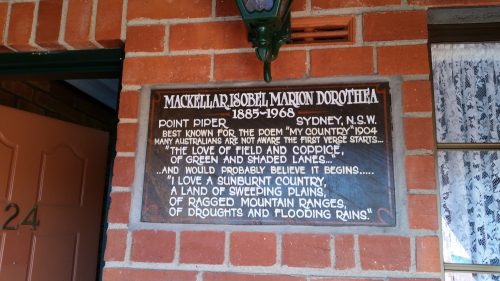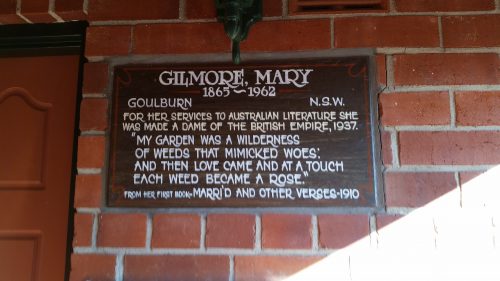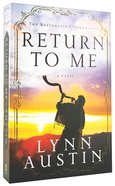A Resting Place for Poets

Poet’s Recall Motel, Gundagai
On a recent trip to Sydney, we stayed one night in the Poet’s Recall Motel in Gundagai. In the past, we have taken only two days to travel from home – Murray Bridge near Adelaide – to our son’s home in Sydney. Due to doctor’s appointments on the day we had planned to leave, we decided to take a more leisurely two and a half days to get to our destination.
On the second night, we had planned to stay in a cabin in the local caravan park in Gundagai. We usually prefer to stay in a cabin because the cooking facilities are generally better in cabins. Of course, I should have booked ahead.
When we arrived at the caravan park, they had no cabins left vacant. The lady in the office told me that rooms were in short supply in the town, and she gave me a few possibilities to try. A few hundred metres away was the Poet’s Recall Motel; what a charming name for a motel. I loved the idea of staying in a motel which acknowledged the role of poetry in our Australian culture.
We managed to get one of the few rooms left that night. It was cosy (read “smallish”) but quite adequate for our needs. Comfortable and clean. On the downside, I had to lug our gear up some stairs, but we only had an overnight bag and a few other items, so I managed okay.
One of the first things I noticed was a plaque on the wall outside our room. Later I noticed that every room had one. Each plaque was a tribute to an Australian poet of note. I have featured two of these plaques above and below. The top one features our well-known poet, Dorothea Mackellar, and the one below Mary Gilmore. I particularly love the quote from Gilmore’s poem.

Poet’s Recall Motel, Gundagai
The Dog on the Tucker Box
Many Australians are familiar with the story of the Dog on the Tuckerbox, made famous in another poem. The tribute to this famous story and poem is featured a few kilometres north of the town of Gundagai. I wrote about several of our visits in posts on my travel blog, Trevor’s Travels. You can read those posts by clicking on the links below.
Further reading:
- The Dog on the Tuckerbox
- Autumn in Gundagai
- Joseph Carberry’s Inn, Gundagai
- Morning tea at Gundagai
- Trevor’s Travels – my blog about our travels here in Australia, Nepal, Thailand, Ethiopia, Morocco and Spain.
On writing one’s memoirs

Confusion
In beginning to write on this topic, I must admit to something of a dilemma and a little confusion. I am quite clear about what an autobiography is, as well as a biography and I have read quite a few in each of those categories. What, therefore, is one’s memoirs? And what should one cover when writing one’s memoirs?
Does it cover every aspect of one’s life – no, that has to be a biography. Biographies cover life to death events – and everything in between, often in chronological order. What I am working on is less than everything I have ever done, or the major events anyway. Many of the mundane happenings in my life are of little or no interest to anyone, even my closest family members. I suspect it would be very boring, except for the odd exciting and interesting event.
A special request
Several months ago my eight-year-old grandson was asking me a whole range of questions about when I was young. This probably came from discussions he had in class at school. We have frequent and long conversations on the phone every few days. Because he lives in Sydney, about 1400 kilometres away (or two days’ drive), this is our main means of keeping in touch and getting to know one another. He has been asking plenty of questions about my early days. It was his interest which motivated me to start recording some of my experiences as a child, and as a young person growing up.
Family interest
While the things I am including in my memoirs are of interest primarily to my grandson, there is also the potential for other family members to be interested in reading such a work. I know that my daughter and my son have both expressed an interest, but my five year old granddaughter is probably not there yet. She has too many other things filling her head. She only started school a few weeks ago. There would also be some of my nephews and nieces who might also be interested, and possibly even my brothers. Beyond that, a few odd friends may have a little interest – but they would have to be quite ‘odd’ indeed.
What to include?
The beauty of memoirs, as opposed to an autobiography, is the subject matter which is included. Biographical writing tends to cover the whole range of events in one’s life, with a special emphasis on the major influences and achievements. In memoirs, however, one can ignore some of the otherwise significant periods of a life, and instead focus on some of the minor snippets, incidents and insights which have become memorable to the subject and have somehow had a profound influence on them. Memoirs can be more of a series of isolated snapshots, rather than a broad, panoramic movie. They are reflections and reminiscences rather than all inclusive biographical records.
While have read a few memoirs, biographies and autobiographies in my time, it is a genre I have not really delved into in depth. I recently came across a wonderful resource, a list of the 100 Must Read Memoirs. I am pleased that I have read several of the titles on this list, I have seen the movie of at least one of them, and several others are on my yet-to-read pile of books.
Recommendations
Please feel free to recommend any memoirs, autobiographies or biographers in the comments. I am always looking for more titles to add to that rapidly growing Must Read list, and to that mighty Waiting-to-be-read pile.
Good reading. Happy, productive writing.
Trevor
Further Reading:
- Memoir or novel – should one fictionalise your life – a fascinating discussion on whether one should turn one’s life into fiction. A very useful and thought-provoking article. I have to admit that there is much of my life woven seamlessly into my novels.
Book review: Return to Me by Lynn Austin

Return To Me by Lynn Austin (Restoration Chronicles #1)
This was the first of Lynn Austin’s books I have read. It is the first of her trilogy in the Restoration Chronicles. Having read the first one, I am sure I will read the following two in the series. I am particularly interested in the third book which features the life of Nehemiah, one of my favourite people of the Bible. The book of Nehemiah is one of my favourites in all of the Bible.
I thoroughly enjoyed this novel and will probably read more of her works in the future. This book is a fictional account of the first group of Jews to return to Jerusalem from captivity in Babylon. It is very true to the historical Biblical account.
The main character of the story is Zechariah. The plot follows his early life growing up in Babylon with all of the hardships endured there, including the pressures to conform to the social moralities of the Babylonian culture and religion, including astrology. The sudden change on the part of King Cyrus is greeted with great joy by the Jews in captivity, and plans are immediately made for them to return to Jerusalem to begin life anew in their home country. The author cleverly portrays the family conflicts which arise, with families being torn apart, some remaining in Babylon, with others leaving for the long journey home.
The reader is given an in-depth impression of the physical hardships endured on the journey and the subsequent struggles to establish themselves in Jerusalem and in the surrounding countryside. The author never shirks from also drawing out in depth the spiritual pressures placed upon this band of people, especially the constant exposure to the paganism and astrology of the neighbouring Samaritans. The stark contrasts between the Jewish faith and the faith of other people living near Jerusalem is explored in many ways in the novel.
Zechariah features prominently in this account. Towards the end of the story, we see him as the prophet whose book we read in the Old Testament. The author strongly portrays a young Zechariah in the early stages of his developing spirituality, and how he has a growing awareness of his special relationship with God. Austin never strays from showing the internal spiritual struggles of Zechariah, as well as his grandfather and mentor, Iddo.
I only have one little criticism: the frequent changes of point of view can take a little getting used to, but overall, this is a very well written and enjoyable account. The novel has one enduring strength: by being written as fiction, the author can draw each character in compelling and intriguing depth, while never losing sight of the facts of the historical foundations of the narrative.
Highly recommended.
Book Review: The Little Desert by Colin Thiele

Book Review: The Little Desert.
Text by Colin Thiele.
Photographs by Jocelyn Burt.
Published by Rigby Limited, Adelaide, 1975.
The Little Desert
This is a region in western Victoria, Australia. It is about midway between Melbourne and Adelaide, being about 350km from either city (about 4 hours travel time). It was in earlier times suggested as an area that needed to be cleared from native vegetation and turned into farming land. In the early 1970s, there was a concerted effort made by conservationists to preserve this unique piece of the Australian landscape. Eventually, it was declared a national park and today it is still one of Australia’s most beautiful places to visit.
Not your typical desert
The area known as the Little Desert is not your typical desert. It only has this title due to the soil type. It is very sandy and lacking in essential nutrients, so it would have been very unsuitable for farming without vast amounts of fertiliser. The ‘desert’ as it has always been, and continues to be, is an area rich in plant life. With over 600 species of plants, it is a magnet for botanists, photographers and nature lovers. It also boasts a rich range of native birds and animal species. Most of the national park is covered in mallee trees. Also present in large numbers are smaller shrubby plants and even a range of beautiful native orchids. In the eastern part of the park, one can see larger eucalypt trees, notably along the Wimmera River which flows through this area.
Poetic prose
Colin Thiele’s beautiful book on this area covers some of the history of the conservation efforts to save this little gem in the Australian landscape. He also describes, in evocative prose, the hidden beauties of this landscape, from the dainty Spider Orchid to the enigmatic Malleefowl, an amazing bird found in the park tending to its enormous nesting mound of sand and rotting vegetation which acts as an incubator to hatch their eggs. Much of Thiele’s prose is closer to poetry, and it is no surprise that he is also known as one of Australia’s leading poets. I will review one of his collections of poetry in a few day’s time.
Photography
Thiele’s wonderful prose is accompanied by equally wonderful photographs by Jocelyn Burt. She has provided photos for several of his other books. The photos cover the flowers and other botanical marvels, as well as some of the many species of birds resident in this area. Every double-page spread in this volume has a photo on the right with Thiele’s text on the left; each one complements the other.
My visits to the desert
Even though this beautiful part of Australia is only a few hour’s drive from my home, it saddens me to write that I can only ever recall visiting the Little Desert on three occasions, once to camp in our old tent, now decommissioned due to a leaking roof, and the other times were fleeting half-day visits. I must correct that oversight soon.
Further reading:
- Mallee trees – some of my photos showing the mallee vegetation similar to the Little Desert.
- Malleefowl – photos of this bird and its nest.
- Can I call you Colin? My review of the official biography of Colin Thiele.
- The Valley Between – my review of a Colin Thiele novel.
Book review: The Valley Between

Book Review: The Valley Between by Colin Thiele, published by Rigby Publishing in 1981.
Biography
Last week I reviewed the official biography of Colin Thiele. You can read that review here. I found this biography to be very interesting and quite inspirational. Thiele was a prolific writer despite also being a full-time teacher and a much-in-demand public speaker. In his day, he was a much-loved author, particularly regarding his works for children of all ages. His new books were always eagerly awaited and sold out quickly. I believe that his writing is still held in high regard, though many younger readers have probably not heard of him. Even younger teachers may not be aware of the huge contribution Thiele made to Australian literature.
Inspired
After reading his biography, I was inspired to reread some of his works. I have a few in my own library, but for some titles, I had to go to my local public library. Not all of his books are available here locally, so I am grateful for the provision of interlibrary loans. (We have access to all the books held in public and some school libraries throughout our state of South Australia.)
The Valley Between
One of the books I choose to read was The Valley Between, a novel for children set in the mid-north of South Australia in the 1930s. The valley in the title refers to the Barossa Valley about an hour’s drive north of Adelaide. This is a world famous wine region. Thiele grew up a short distance north of this valley. He was born in 1920 and so this book very much reflects his boyhood experiences and exploits. It would be interesting to know how much is from personal experience, and how much is from his very fertile imagination. This story roughly continues from his earlier and better-known novel, The Sun on the Stubble. Both were later adapted into a television series. Probably his best-known work is Storm Boy which later became a very popular film of the same name. A remake of the film is under way this year (2017).
Vignettes
The narrative of The Valley Between is mostly in short vignettes of the happenings in the life of the protagonist, Benno Schulz. Each chapter is an episode in itself, but the over-arching storyline follows Benno’s first experiences after leaving primary school. In those days, many children did not go on to secondary or tertiary education.
While each chapter can be read in isolation just like a short story, several characters appear in each episode, intersecting with the life of Benno as he grows up on a farm near the imaginary town of Gonunda. The town is quite clearly reflective of the town of Eudunda where Thiele grew up. There is a statue of Thiele in a park of the town.
.jpg)
German influences
Many of the characters in the story are descendants of the German settlers who came to South Australia in the 1800s. Thiele uses their distinct dialect, a mixture of English, German and mash-ups of both languages to great effect. He has even included a glossary of German words at the back. I, too, have the same heritage, so the language is easy for me to read. Contemporary readers may struggle a little until they get used to it. This is a small price to pay for reading this delightful story. Many incidents are laugh out loud moments as Benno gets into all kinds of adventures, both deliberate and inadvertent.
Descriptions
Colin Thiele is known for his rich descriptions of the environment in which his stories are based. His words sing with metaphors and similes which bring his settings to life. His wonderful characters come to life through his words and their sometimes bizarre actions and attitudes. While I have said that this book is somewhat episodic in structure, the narrative carries the reader on to the satisfying conclusion.
When I first came across this title in a list of his works, I thought that I had missed reading this title. On getting about half way through, I realised that I had read it, albeit several decades ago, possibly when it was first published. It is well worth tracking down a copy to read.
Further reading:
- Can I call you Colin? My review of the official biography of Colin Thiele.
_small.JPG)
Colin Thiele